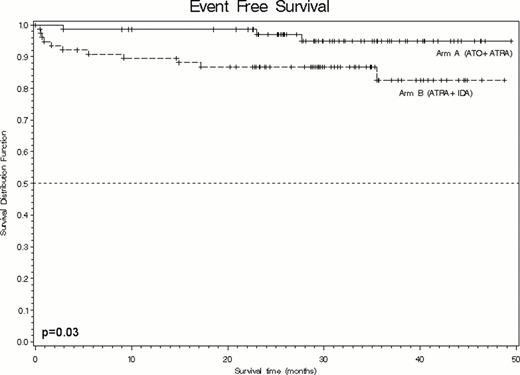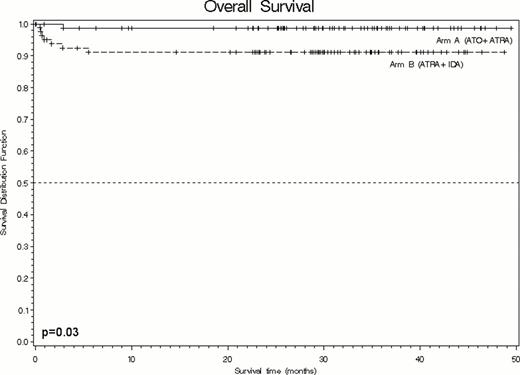Abstract
Abstract 6
Simultaneous ATRA and chemotherapy (CHT) is the current gold standard for newly diagnosed APL resulting in ∼80% cure rates, while arsenic trioxide (ATO) is the treatment of choice for relapsed patients. ATO in variable combinations including ± ATRA ± CHT has also been tested as front-line therapy yielding encouraging results in several pilot studies as well as in two phase III studies conducted in China and the US. So far, no randomised studies have compared front-line CHT-free ATO+ATRA combination against the standard ATRA+CHT approach.
The phase III, randomised, prospective APL0406 trial was started in October 2007 by the Italian GIMEMA group and joined in November 2008 by the German SAL and AMLSG multicenter groups. Eligible patients were adults aged 18-<71 years with newly diagnosed, genetically confirmed, non-high-risk (WBC≤10×109/L) APL. Patients were randomized to receive the ATO+ATRA combination originally reported by the MD Anderson group (Estey et al. Blood 2006, arm A), or the Italian AIDA2000 risk-adapted protocol for non high-risk disease (arm B). Patients in arm A received ATO 0.15/kg plus ATRA 45 mg/m2 daily until CR, then ATO 5 days/week, 4 weeks on 4 weeks off, for a total of 4 courses and ATRA 2 weeks on and 2 weeks off for a total of 7 courses. Patients in arm B received the standard AIDA (ATRA+Idarubicin) induction followed by 3 cycles of anthracycline-based plus ATRA consolidation and low dose CHT and ATRA for maintenance as reported (Lo-Coco et al., Blood 2011). The primary study objective was EFS at 2 years. The study was designed to show that the rate of patients alive event-free at two years in the experimental treatment arm is at least 80%. Secondary objectives included OS, DFS, CIR rates, molecular response and toxicity profile.
From October 2007 to September 2010, the required sample size of 162 enrolled patients was completed. Median age was 45.3 years (18.7–70.2 years) and median WBC 1.50 × 109/L. As to the Sanz's risk score, 61.8% and 38.2% of patients were in the intermediate- and low-risk categories, respectively. The two treatment arms were well balanced for main baseline characteristics including age, sex, median WBC and Sanz's score. Eight patients were not evaluable for induction due to ineligibility or protocol violation. Of 154 patients evaluable for response to induction, CR was achieved in 150 (97.4%): 75/75 (100%) in arm A vs 75/79 (95%) in arm B (P=0.12). After a median follow-up of 31 months (range 0.07–50.4) the 2 year EFS (primary objective) was 97% (C.I.95%: 93.1–100) and 86.7% (C.I.95%: 80.3–93.6) in arms A and B respectively (P=0.03). There were 1 death in CR and 2 relapses in arm A, and 7 deaths (4 in induction, 3 in CR) and 4 relapses in arm B. As to secondary objectives, OS, DFS, and CIR rates were 98.7% vs. 91.1% (P=0.03), 97% vs. 91.6% (P=0.19) and 1.6% vs. 4.3% (P=0.41) in arm A and B, respectively. Fever episodes, prolonged (>15 d) grade ≥ 3 neutropenia and thrombocytopenia were significantly more frequent in patients in arm B as compared to those in arm A (P <.001 for all comparisons). Other side effects including differentiation syndrome and increase of liver enzymes were recorded with similar frequency in the two study arms. Two patients in arm A had QTc prolongation requiring ATO discontinuation with final withdrawal in one case. PCR analysis of PML/RARA (sensitivity 10−4) was centrally performed in Rome (F. Lo-Coco) and Dresden (C. Thiede) and showed molecular CR in 141/142 (99%) of evaluable patients after completion of 3rd consolidation. One patient in arm B who tested PCR-positive at this time point was considered resistant and taken off protocol as per study design.
For patients with newly diagnosed non-high-risk APL, as compared to the standard AIDA regimen, the front-line CHT-free ATO+ATRA combination is at least not inferior for 2 year EFS.
Lo-Coco:Boehringer Ingelheim: Membership on an entity's Board of Directors or advisory committees; Cephalon: Speakers Bureau. Off Label Use: Arsenic Trioxide (ATO) is currently approved for therapy of relapsed APL in the US and Europe. In this study the role of ATO in front-line therapy of APL is explored. Fiedler:Pfizer Inc.: Consultancy, Research Funding; Novartis: Consultancy, Research Funding. Breccia:Celgene: Honoraria; Novartis: Honoraria; BMS: Honoraria. Platzbecker:GlaxoSmithKline: Consultancy; Celgene: Consultancy; Novartis: Consultancy; Amgen: Consultancy.
Author notes
Asterisk with author names denotes non-ASH members.



This feature is available to Subscribers Only
Sign In or Create an Account Close Modal